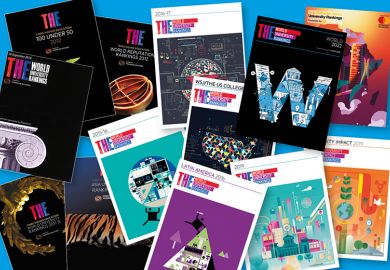Browse the full results of the World University Rankings 2024
At Times Higher Education, we try to think of our various rankings as part of different groupings (although increasingly some cross boundaries). These reflect different university missions: research, teaching and sustainability.
Rather than trying to blend these rankings into a super-ranking, we think it is better to evaluate these areas independently. A sustainability measure in the research rankings, for example, would be swamped by other data, and would be little better than a token – giving newer universities no opportunities to demonstrate their excellence.
I have already written about the changes we have made to this year’s World University Rankings, and my colleagues have put this into the context of the past 20 years (here and here). Now it is time to look to the future – at least as far as next year.
Research rankings
With the World University Rankings now including more than 1,900 institutions, it is undoubtedly still our flagship ranking. The changes we have introduced this year will be carefully evaluated to ensure they have the desired impact.
These changes will also be rolled out across our other related rankings so that we have a consistent set of measures wherever possible.
The nature of research itself is something we are very interested in. Our exploration of the citation measures has deepened our understanding of the complexities involved, especially when it comes to interdisciplinary research. The structures of higher education tend towards the hierarchical, and yet some of the best research is carried out across these boundaries.
Over the course of the year, we have been gathering data from universities on how they support interdisciplinary research – specifically, for the time being, in the area of science. The results are interesting, and highlight some of the challenges faced when trying to ensure this critical research is well supported.
We will be reviewing the data and expect to move towards publishing a formal Interdisciplinary Science Ranking next year.
Sustainability rankings
We have already announced that we won’t be changing the questions in the methodology for next year’s Impact Rankings, but there are a few other changes that we might make.
We want to expand our Impact Rankings advisory board (it currently includes 10 members). Already we hold two separate meetings because the geographical spread of members makes holding a single meeting difficult. As a result, it makes sense to expand membership and have two larger groups.
One of the key decisions we will be discussing with them is how to grow participation in the rankings further, and what that might mean for the overall ranking. Already the Impact Ranking are, by a considerable way, the world’s largest rankings focused on sustainability. As we grow them – hopefully – past 2,000 participants, the way we allow universities to demonstrate their fantastic progress becomes more and more important. Should we continue to have a single ranking, or should we find another way to showcase institutions?
Of course, the Impact Rankings have a critical role to play in helping universities to understand the opportunities they have to deepen their sustainability activities, and in helping governments learn about how their higher education sectors are supporting their actions in addressing the United Nations’ Sustainable Development Goals (SDGs). This year, we have been able to use the data to showcase the actions of higher education at the Civil20 India Summit, as well as to numerous governments around the world.
Teaching rankings
After discussions with our partner Benesse, we have decided to pause the Japan University Rankings for a year. As a result, the next edition will be published in March 2025. There have been significant changes in the rankings landscape in Japan, and we feel that this pause will allow Japanese universities time to assimilate these changes and further recover from the impacts of the Covid-19 pandemic.
A new initiative is under way at THE to explore the growing world of online higher education. This is an area that is both a challenge to traditional modes of teaching, and one that is yet to have a single established way of working.
Although the roots of online education can be traced back at least as far as the 1960s, when The Open University was established in the UK, online learning was given a significant boost during the Covid-19 pandemic when distance learning became the de facto mode of education for many.
There are many potential avenues for our exploration, including microcredentials and alternative providers, but initially we will be looking at institutions providing full-length degree courses.
We expect to start the process of gathering data this year, and will be exploring options with institutions.
Other rankings
This year, we launched our first ever Sub-Saharan Africa University Rankings, in partnership with the Mastercard Foundation. We are very excited about this ranking, which blends elements of teaching, research and impact.
At our launch event at Ashesi University in June, the opportunities for higher education across Africa were made very clear, and we look forward to developing the ranking further. The next edition will be launched in December 2024 – the extra time giving an opportunity for greater university participation and for our advisory board to help us shape the metrics.
Our Arab University Rankings are also configured to provide insights specific to that very dynamic region. The third edition, published this autumn, will see the ranking continue to expand, while at the same time tweaks have been made to the methodology to better reflect regional trends.
Finally, the World Reputation Rankings in their current form use data from our much-expanded academic reputation survey. It has become well established as a great metric for the overall brand value of universities, focusing on the top 200 university brands in the world.
One of the things that has always interested me is how we could expand this ranking to explore other aspects of reputation and brand. We are currently in the very early stages of this exploration, but hope that any changes will enable the World Reputation Rankings to provide broader insight that will be useful to university leaders and marketing teams.
Our rankings
Our research rankings include our:
- World University Rankings
- World University Rankings by subject
- Asia University Rankings
- Latin America University Rankings
- Young University Rankings
- Interdisciplinary Science Ranking (new)
Our sustainability rankings include our:
Our teaching rankings include our:
- Japan University Rankings
- Online Learning Ranking (new)
We also produce the following rankings that don’t fit exactly into any of the above categories:
- Arab University Rankings
- Sub-Saharan Africa University Rankings
- China Subject Ratings
- World Reputation Rankings
For all our rankings we maintain the principle that participation should be free for universities, and that it will remain voluntary.
We will continue to invest in data collection and data quality to ensure that the results we provide are as useful and as insightful for the sector as possible.
Duncan Ross is chief data officer at Times Higher Education.
Register to continue
Why register?
- Registration is free and only takes a moment
- Once registered, you can read 3 articles a month
- Sign up for our newsletter
Subscribe
Or subscribe for unlimited access to:
- Unlimited access to news, views, insights & reviews
- Digital editions
- Digital access to THE’s university and college rankings analysis
Already registered or a current subscriber? Login








